El ser que apareció entre las ruinas del asentamiento de esclavos || The being that appeared among the ruins of the slave settlement
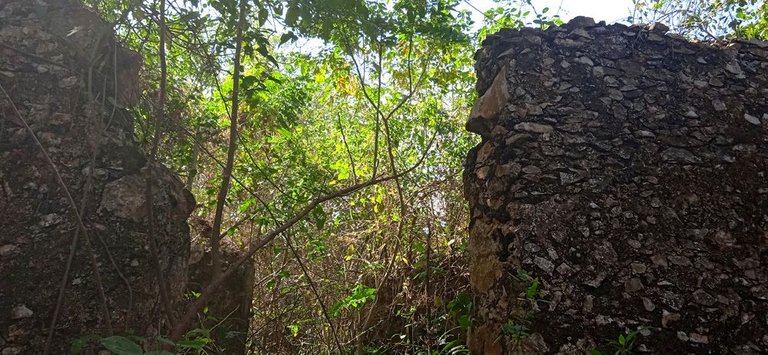
En esa tupida maleza, las pieles hincadas por los espinos, el peligro de un derrumbe, y entre paredes que no olvidan el dolor de los esclavos; sentimos una presencia que asustó a todos…
Hola familia de #Hive y de #HiveCuba. El 12 de febrero de 2023, fue un domingo lleno de lindas experiencias. Decidimos dejar la ciudad, para aventurarnos en la Provincia de Mayabeque.
Neyder, Juan, Edgar y yo, partimos desde bien temprano portando nuestros detectores de metales, para desenterrar historias. En plena calle estrecha, cerca del pueblo de Aguacate, el polvo arcilloso empanizó el carro, penetrando en cada lugar. Divisamos a nuestra derecha, y a lo lejos, los vestigios de lo que fue la casa de los Bolaños; una familia con grandes relaciones, y acaudalada económicamente, que abandonó el país hace años.
Decidimos llegar hasta allí a través de un camino de tierra empedrado que nos llevó a pocos metros del lugar. Sólo quedaba de su morada, la estructura externa y las divisiones interiores. Sin ventanas ni techo, todo en total decadencia, y siendo la vegetación, los inquilinos que se han adueñado de cada espacio de lo que fue una bella propiedad cimentada encima de una colina.
In that dense undergrowth, the skins driven by thorns, the danger of a landslide, and between walls that do not forget the pain of the slaves; we felt a presence that frightened everyone....
Hello #Hive and #HiveCuba family. February 12, 2023, was a Sunday full of beautiful experiences. We decided to leave the city, to venture into the province of Mayabeque.
Neyder, Juan, Edgar and I set out early in the morning with our metal detectors to unearth stories. In the middle of a narrow street, near the town of Aguacate, the clay dust made the carriage muddy, penetrating in every place. We spotted to our right, and in the distance, the remains of what was the Bolaños' house; a family with great relations, and economically wealthy, who left the country years ago.
We decided to get there through a cobblestone dirt road that took us a few meters from the place. All that remained of her dwelling was the external structure and the interior partitions. Without windows or roof, everything in total decay, and being the vegetation, the tenants that have taken over every space of what was a beautiful property cemented on top of a hill.

[Entre Juan y Neyder/Between Juan and Neyder]
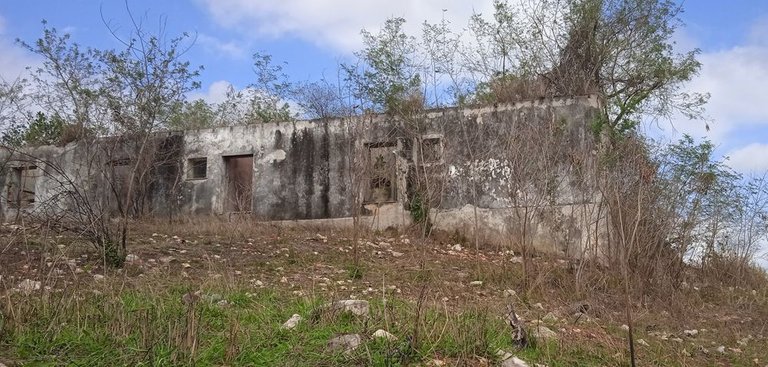
Los arquitrabes agrietados y con grandes piedras, nos apuntaban desafiando la gravedad. Sin cascos en la cabeza, era un peligro real desplazarnos entre los gajos enmarañados, como los tentáculos de un pulpo.
Después de revisar los exteriores, y la zona base de la colina, donde reposaban piedras duras y pulidas por los años, sólo sacamos basura metálica de material ferroso.
El otro punto de destino, era el municipio Madruga, lugar de asentamientos aborígenes, ingenios, y bien conocido por el uso de sus aguas minerales para tratar diversas enfermedades y problemas terapéuticos de la salud.
Municipio, que tiene un lugar del que no se habla mucho, pero atesora una historia real. Ahí se erigía, uno de los asentamientos de esclavos de la Habana. Hoy, entre los lugareños, se le conoce como las “Ruinas de Carriera”.
A ese lugar no se puede llegar en carro. Parqueamos en la casa de unos campesinos que viven a pocos metros de la calle. Varios perros nos recibieron con sus ladridos, y los familiares del jefe de la familia, nos dieron entrada con esa amabilidad que caracteriza a nuestros campesinos. Almorzamos, para recuperar energía con lo que nos trajimos desde casa, y fue que conocimos a Juan, el mayor y el eje de esa familia, que llegaba con su escuálido caballo a su bohío; portando un machete en su cintura. Se ofreció para servirnos de guía, a pesar de sus más de 80 años de edad. Nos hizo saber, que por ese lugar han pasado arqueólogos y muchas personas, con equipos de detección, una vez que supo los motivos de nuestro viaje.
The cracked architraves and large stones pointed at us in defiance of gravity. Without helmets on our heads, it was a real danger to move among the tangled gores, like the tentacles of an octopus.
After checking the exteriors, and the base of the hill, where hard stones rested, polished by the years, we only took out metallic garbage of ferrous material.
The other destination was the municipality of Madruga, a place of aboriginal settlements, sugar mills, and well known for the use of its mineral waters to treat various diseases and therapeutic health problems.
Municipality, which has a place that is not much talked about, but treasures a real history. One of the slave settlements of Havana used to stand there. Today, among the locals, it is known as the "Ruins of Carriera".
This place cannot be reached by car. We parked in the house of some peasants who live a few meters from the street. Several dogs greeted us with their barking, and the relatives of the head of the family, gave us entrance with that kindness that characterizes our peasants. We had lunch, to recover energy with what we brought from home, and we met Juan, the eldest and the axis of that family, who arrived with his scrawny horse to his hut; carrying a machete on his waist. He offered to serve as our guide, despite his 80 years of age. He let us know that archaeologists and many people with detection equipment have passed through this place, once he knew the reasons for our trip.
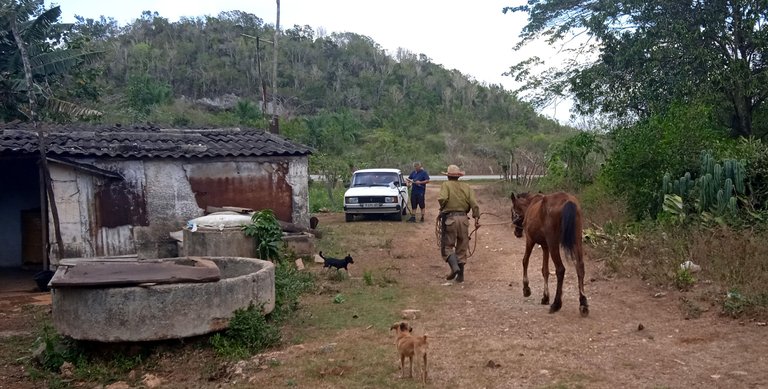
Iniciamos el ascenso por la pendiente de una loma, y a unos 300 metros, a nuestra izquierda se ubicaba un apiario o colmenar, de dominio estatal, para colectar la preciada miel de abejas y otros productos.
We began the ascent up the side of a hill, and about 300 meters away, on our left was a apiary, owned by the State, to collect the precious honey bees and other products.
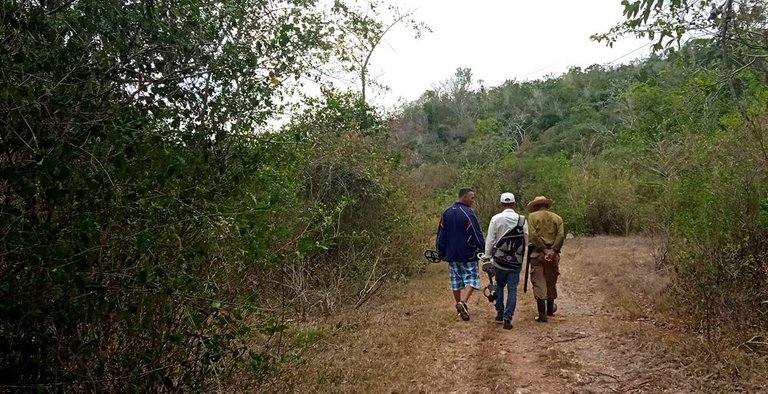
[Edgar, Juan y el campesino/Edgar, Juan and the farmer]
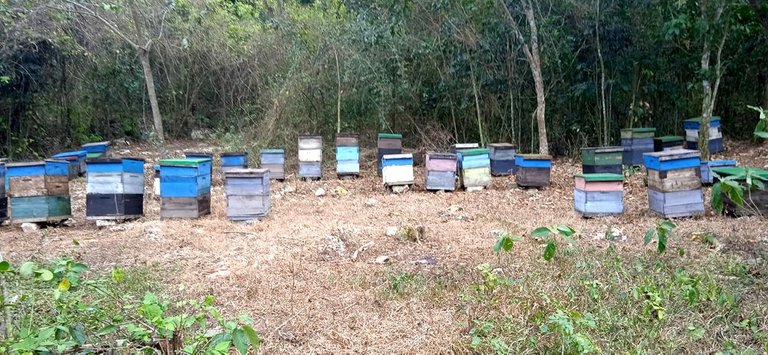
Avanzamos otros cientos de metros, y nos desviamos en dirección a un gran árbol de Jagüey, el que pertenece al género Ficus, familia de las Moráceas, y se distinguen por tener raíces aéreas. Popularmente, simboliza a la ingratitud y la traición, porque abraza a otras plantas hasta aniquilarlas. Sus frutos o higos se pueden consumir; sus hojas son usadas para tratar enfermedades hepáticas; y son fuentes de agua para muchas especies, en épocas de sequía.
Por la anchura de su tronco, se puede tener idea de los años de su gran antigüedad. Una época donde las personas escondían su dinero y objetos de valor, cerca de la base de grandes árboles; que les servían de guía, para después recuperarlos; en momentos, donde no existían o acceder a un banco les era imposible.
Nos percatamos, que el lugar reflejaba las marcas del paso de otros detectoristas, por la remoción de la tierra entre las raíces, y las depresiones circundantes. El campesino Juan, sentado sobre una de las piedras, nos miraba fijamente, con esa seguridad, de que a sus ojos, éramos como niños jugando al explorador en su entorno. Me llegaba al verlo, que sabía que nada de valor encontraríamos. Efectivamente, sólo fragmentos de alambres y planchas metálicas, fue lo encontrado alrededor del viejo árbol.
We advanced another hundred meters, and we turned off in the direction of a large Jagüey tree, which belongs to the genus Ficus, family of Moraceae, and is distinguished by its aerial roots. Popularly, it symbolizes ingratitude and betrayal, because it embraces other plants until it annihilates them. Its fruits or figs can be consumed; its leaves are used to treat liver diseases; and are sources of water for many species in times of drought.
By the width of its trunk, you can get an idea of the years of its great antiquity. A time when people hid their money and valuables near the base of large trees, which served as a guide, to later recover them, at times when they did not exist or access to a bank was impossible.
We noticed that the place reflected the marks of the passage of other detectorists, by the removal of the earth between the roots, and the surrounding depressions. The farmer Juan, sitting on one of the stones, stared at us, with that certainty that in his eyes, we were like children playing explorer in his environment. It came to me when I saw him, that I knew that we would find nothing of value. Indeed, only fragments of wires and metal plates were found around the old tree.
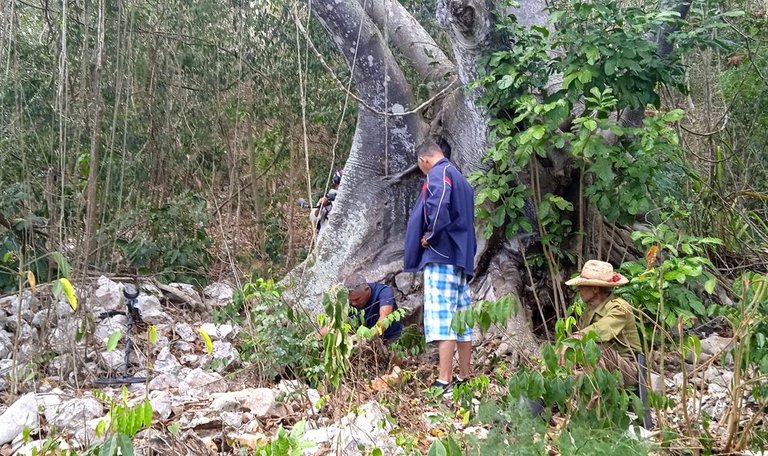
De ahí nos dirigimos a las ruinas, de lo que antes fue el lugar donde vivían los esclavos. El paso se hacía con dificultad, había que cruzar cercas de alambre de púas, la ropa se nos llenaba de guisazo, y las espinas de los gajos de Marabú, acechaban como lanzas y garfios para hincar nuestra piel, y limitarnos el avance, al engancharse en nuestras vestimentas.
El campesino que se conoce los detalles de la zona, a pesar del calor y del sol incidiendo a plenitud, llevaba su camisa de mangas largas, y su pantalón dentro de sus botas de goma, abriendo paso con su machete para poder minimizar a los espinos, y que pudiéramos continuar la marcha.
From there we headed to the ruins of what used to be the place where the slaves lived. The passage was difficult, we had to cross barbed wire fences, our clothes were full of guisazo, and the thorns of the branches of Marabú, lurked like spears and hooks to drive our skin, and limit our progress, hooked in our clothes.
The farmer who knows the details of the area, despite the heat and the full sun, wore his long-sleeved shirt, and his pants inside his rubber boots, opening the way with his machete to minimize the thorns, and we could continue the march.
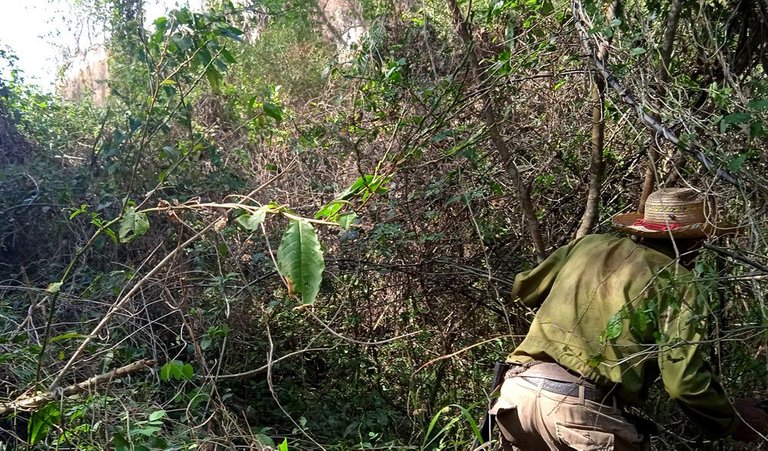
A los pocos minutos llegamos a las ruinas: unas gruesas paredes de piedra, lo que antes fueron los parajes donde dormían los esclavos, hasta los finales del siglo XVIII y XIX. Usados para el trabajo fuerte, en los cafetales, y sobre todo, en los cañaverales de Cuba, y que eran castigados por sus dueños, mayordomos y mayorales, si no cumplían sus obligaciones.
A few minutes later we arrived at the ruins: some thick stone walls, what used to be the places where slaves slept, until the end of the XVIII and XIX centuries. They were used for hard labor in the coffee plantations, and above all, in the sugar cane fields of Cuba, and were punished by their owners, mayordomos and mayorales, if they did not fulfill their obligations.
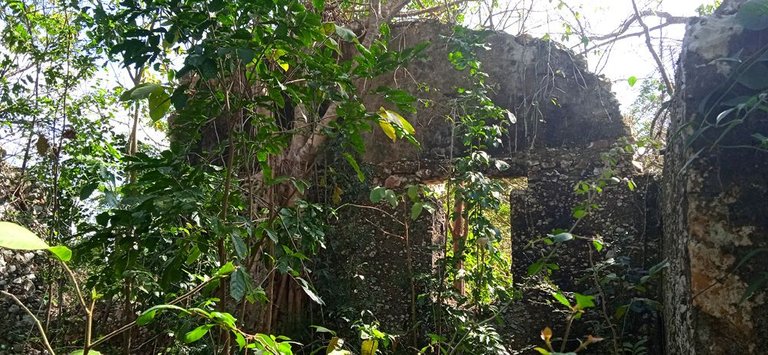
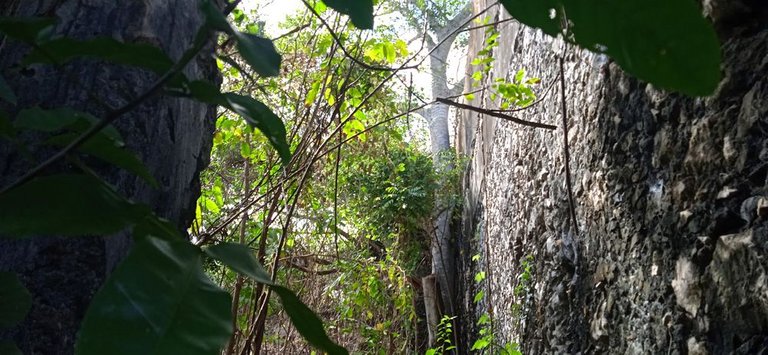
Muchos, en rebeldía al sistema esclavista, se suicidaban, atentaban contra las propiedades, y los hijos que tenían con sus amos; o se fugaban a los montes, lugares ocultos y cuevas, para su liberación, convirtiéndose en cimarrones. Otros, pudieron salir de la isla en embarcaciones, a través del pago a ciertos contactos. En la década de 1880, la esclavitud en nuestro país, llegaba a su fin.
¿Por qué un lugar donde permanecían esclavos, puede ser atractivo a los detectoristas?
Porque los esclavos, con el fin de lograr su libertad, se las ingeniaban en conseguir y guardar el dinero en lugares ocultos. Los que no lo lograban, a veces morían, portando sus monedas en sus atuendos.
Entre esa maleza, y con poca visibilidad entre nosotros, sentimos el sonido de algo inesperado. Algo se desplazaba con rapidez hacia donde estábamos, sin que pudiéramos ver de qué se trataba. Por un instante, nos quedamos quietos, en posición de alerta.
A los pocos segundos, apareció ante nuestros ojos, un niño corriendo. Estaba en short, con el torso al descubierto, y sin calzado. Un tirapiedras colgaba de su cuello, como su mejor trofeo. Nos dijo que vive cerca, y se acercó con premura al sentir nuestras voces.
Nos sorprendió ver, como se desplazaba y corría en ese monte, con total naturalidad y sin quejarse de nada, y nosotros hasta con la ayuda del campesino nos costaba caminar con libertad. Se motivó unirse a nuestra actividad, y siguió a Juan, que portaba su detector con audífonos.
Más adelante, encontramos vestigios de un pozo; y según cuentan las historias locales, entre la distancia entre éste y una casita que dista a casi 100 metros, loma arriba, hay enterrado un tesoro con monedas de oro. Así que podrán imaginar, cuantas personas han visitado el lugar, sin resultado alguno. Quizá, el supuesto botín está en otro lugar, y dicen eso para despistar, o simplemente nunca sucedió.
Llegamos a la pequeña casa, la que estaba abandonada, pero era una construcción posterior, no del tiempo de la etapa esclavista. Revisamos el trayecto de las zonas cercanas, incluidas otras ruinas de paredes.
Many, in rebellion to the slave system, committed suicide, attacked their property and the children they had with their masters, or escaped to the mountains, hidden places and caves for their liberation, becoming maroons. Others were able to leave the island in boats, through the payment of certain contacts. In the 1880s, slavery in our country came to an end.
Why would a place where slaves were kept be attractive to detectorists?
Because the slaves, in order to achieve their freedom, managed to get and keep the money in hidden places. Those who did not succeed, sometimes died, carrying their coins in their attire.
In the undergrowth, and with little visibility between us, we felt the sound of something unexpected. Something was moving rapidly towards us, without our being able to see what it was. For an instant, we stood still, in a position of alertness.
A few seconds later, a boy appeared before our eyes, running. He was in shorts, with his torso uncovered, and without shoes. A handmade slingshot was hanging from his neck, like his best trophy. He told us that he lives nearby, and rushed over when he heard our voices.
We were surprised to see how he moved and ran in the bush, with total naturalness and without complaining about anything, and even with the help of the farmer it was difficult for us to walk freely. He was motivated to join our activity, and followed Juan, who was carrying his detector with headphones.
Further ahead, we found traces of a well; and according to local stories, between the distance between it and a small house that is almost 100 meters away, up the hill, there is buried a treasure with gold coins. So you can imagine how many people have visited the place, without any result. Perhaps, the supposed booty is somewhere else, and they say that to mislead, or it simply never happened.
We arrived at the small house, which was abandoned, but it was a later construction, not from the time of the slave era. We checked the path of the nearby areas, including other ruins of walls.
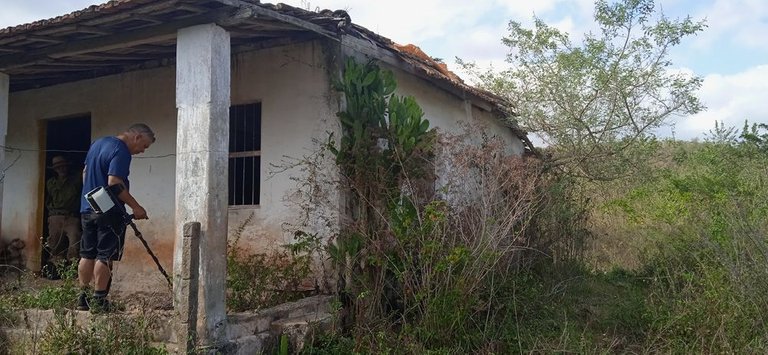
Eran cerca de las 4 de la tarde, decidí antes de regresar a donde dejamos el carro, pasar por un punto de marcación que dejé en la parte posterior del Jagüey. Neyder, lo revisó con el detector de profundidad Detech Relic Striker, y al escarbar, sólo salió una lámina de metal, como las tantas que encontramos ese día.
Junto a Edgar y el campesino, poníamos fin a la aventura del día; pero el niño quiso llevar a Neyder y a Juan, a pasar los detectores por una supuesta y pequeña capilla funeraria.
Eran las 6 p. m. y el sol se estaba poniendo por el oeste, y fue cuando regresaron ellos dos. Juan encontró lo que parecía ser la parte cóncava de una cuchara en la zona de la capilla y el niño la quiso de recuerdo. Pero antes de despedirse, les dijo: un día seré un detectorista como ustedes. Guardo todo lo que me he encontrado en la zona, desde botellas hasta pedazos de metales raros. Si quieren, hablaré con mi papá, para ver si les cambia uno de sus chivos, por el detector gris y sus audífonos.
It was about 4 o'clock in the afternoon, and before returning to where we left the car, I decided to pass by a marking point that I had left at the back of the Jagüey. Neyder, checked it with the depth detector Detech Relic Striker, and when we dug, only a sheet of metal came out, like the many we found that day.
Together with Edgar and the farmer, we put an end to the day's adventure; but the boy wanted to take Neyder and Juan to pass the detectors through a supposed small funeral chapel.
It was 6 p.m. and the sun was setting in the west, and that's when the two of them returned. John found what appeared to be the concave part of a spoon in the chapel area and the boy wanted it as a souvenir. But before saying goodbye, he told them: one day I will be a detectorist like you. I keep everything I have found in the area, from bottles to pieces of rare metals. If you want, I'll talk to my dad, to see if he'll trade you one of his goat for the gray detector and his headphones.
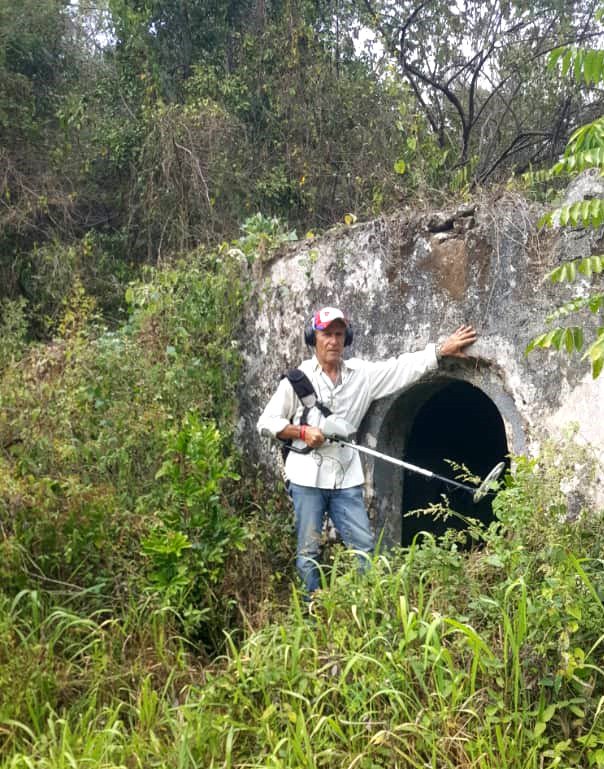
[Juan a la entrada de la capilla/ Juan at the entrance of the chapel]
Juan y Neyder, le agradecieron por su compañía, y antes de tomar rumbo a su casa, el niño quiso que le tomaran una foto, junto al detector; partiendo con nuevos sueños y con la felicidad de haber compartido unas horas junto a nosotros. Estamos seguros que un día lo logrará, y que podrá sustituir su tirapiedras por un detector de metales.
Juan and Neyder, thanked him for his company, and before heading home, the boy wanted to have his picture taken with the detector; leaving with new dreams and with the happiness of having shared a few hours with us. We are sure that one day he will make it, and that he will be able to replace his handmade slingshot for a metal detector.

Al despedirnos del campesino y su familia, le prometí al viejo Juan, que si un día volvemos, le regalaré los cigarros que le gustan; y recordando su mirada cuando estábamos al pie del Jagüey, le pasé el brazo encima del hombro, y le dije:
Juan, los tesoros ocultos aparecen si están por destino ser revelados ante una persona específica; aún, sin que tenga que usar equipos electrónicos de detección. Sonrió y asintió con la cabeza a mis palabras.
…Nuestro mayor tesoro, fue compartir un bonito día, el conocerlo, y sentir de cerca, la hospitalidad y sencillez, que recibimos de usted, su familia; y de ese niño, que sin tener un detector, ya se comporta como un detectorista, que con sus manos y siguiendo a sus instintos, ha sabido recopilar diversos objetos, que son parte de la historia que atesoran las “Ruinas de Carriera”.
As we said goodbye to the farmer and his family, I promised old Juan, that if one day we return, I will give him the cigars he likes; and remembering his look when we were at the foot of the Jagüey, I passed my arm over his shoulder, and told him:
Juan, hidden treasures appear if they are meant to be revealed before a specific person; even, without having to use electronic detection equipment. He smiled and nodded his head at my words.
...Our greatest treasure was to share a beautiful day, to meet you, and to feel the hospitality and simplicity that we received from you, your family, and from that child, who without having a detector, already behaves like a detectorist, who with his hands and following his instincts, has been able to collect various objects that are part of the history that the "Ruins of Carriera" treasure.
Fuentes revisadas/Sources reviewed:
Ecured
Rebeldías y resistencias esclavas en la historiografía sobre Cuba, siglo XIX. Por Amparo Sánchez Cobos.
Fotos tomadas con mi teléfono celular Xiaomi Redmi 9A/Photos taken with my cell phone Xiaomi Redmi 9A
Text by Andrés Brunet
@abrunet
Gracias por leer/Thank you for reading
Bienvenidos sus comentarios/Welcome your comments
¡Saludos infinitos!/Infinite greetings!
https://twitter.com/1535333108651900928/status/1625402551150551041
The rewards earned on this comment will go directly to the people sharing the post on Twitter as long as they are registered with @poshtoken. Sign up at https://hiveposh.com.
Ha sido muy grato leer su crónica. Es cierto, en estas aventuras de búsquedas y encuentros de 'tesoros escondidos' lo mejor que se haya es el conocimiento de lugares, de personas y, sobre todo, de la naturaleza y la historia. Gracias por compartir.
Así es. Ahí radica la esencia de todo, en salir a disfrutar la aventura, y desenterrar historias. Es el mejor tesoro que nos podemos llevar. Con los años, de eso nos energizamos, de los lindos recuerdos, porque lo material es efímero. Saludos: @abrunet